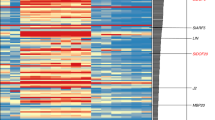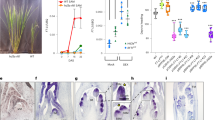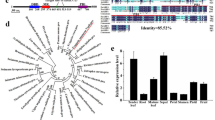Abstract
A well-defined set of regulatory pathways control entry into the reproductive phase in flowering plants, but little is known about the mechanistic control of the end-of-flowering despite this being a critical process for optimization of fruit and seed production. Complete fruit removal, or lack of fertile fruit-set, prevents timely inflorescence arrest in Arabidopsis, leading to a previous proposal that a cumulative fruit/seed-derived signal causes simultaneous ‘global proliferative arrest’. Recent studies have suggested that inflorescence arrest involves gene expression changes in the inflorescence meristem that are, at least in part, controlled by the FRUITFULL–APETALA2 pathway; however, there is limited understanding of how this process is coordinated at the whole-plant level. Here, we provide a framework for the communication previously inferred in the global proliferative arrest model. We show that the end-of-flowering in Arabidopsis is not ‘global’ and does not occur synchronously between branches, but rather that the arrest of each inflorescence is a local process, driven by auxin export from fruit proximal to the inflorescence apex. Furthermore, we show that inflorescences are competent for arrest only once they reach a certain developmental age. Understanding the regulation of inflorescence arrest will be of major importance to extending and maximizing crop yields.
This is a preview of subscription content, access via your institution
Access options
Access Nature and 54 other Nature Portfolio journals
Get Nature+, our best-value online-access subscription
$29.99 / 30 days
cancel any time
Subscribe to this journal
Receive 12 digital issues and online access to articles
$119.00 per year
only $9.92 per issue
Buy this article
- Purchase on Springer Link
- Instant access to full article PDF
Prices may be subject to local taxes which are calculated during checkout






Similar content being viewed by others
Data availability
All figures in this manuscript are associated with raw data. All data will be made available upon request.
References
Khan, M. R., Ai, X. Y. & Zhang, J. Z. Genetic regulation of flowering time in annual and perennial plants. Wiley Interdiscip. Rev. RNA 5, 347–359 (2014).
Hensel, L. L., Nelson, M. A., Richmond, T. A. & Bleeker, A. B. The fate of inflorescence meristems is controlled by developing fruits in Arabidopsis. Plant Physiol. 106, 863–876 (1994).
Wuest, S. E., Philipp, M. A., Guthörl, D., Schmid, B. & Grossniklaus, U. Seed production affects maternal growth and senescence in Arabidopsis. Plant Physiol. 171, 392–404 (2016).
Balanzà V. et al. Genetic control of meristem arrest and life span in Arabidopsis by a FRUITFULL–APETALA2 pathway. Nat. Commun. 9, 565 (2018).
Feng, S. et al. Coordinated regulation of Arabidopsis thaliana development by light and gibberellins. Nature 451, 475–479 (2008).
Serrano-Mislata, A. et al. DELLA genes restrict inflorescence meristem function independently of plant height. Nat Plants 3, 749–754 (2017).
Bennett, T. et al. The Arabidopsis MAX pathway controls shoot branching by regulating auxin transport. Curr. Biol. 16, 553–563 (2006).
Prusinkiewicz, P. et al. Control of bud activation by an auxin transport switch. Proc. Natl Acad. Sci. USA 106, 17431–17436 (2009).
Gustafson, F. Auxin distribution in fruits and its significance in fruit development. Am. J. Bot. 26, 189 (1939).
Bangerth, F. Dominance amongst fruits/sinks and the search for a correlative signal. Physiol. Plant. 76, 608–614 (1989).
Serrani, J. et al. Inhibition of auxin transport from the ovary or from the apical shoot induces parthenocarpic fruit-set in tomato mediated by gibberellins. Plant Physiol. 153, 851–862 (2010).
Kanno, Y. et al. Comprehensive hormone profiling in developing Arabidopsis seeds: examination of the site of ABA biosynthesis, ABA transport and hormone interactions. Plant Cell Physiol. 51, 1988–2001 (2010).
Ferguson, A. C. et al. Biphasic regulation of the transcription factor ABORTED MICROSPORES (AMS) is essential for tapetum and pollen development. New Phytol. 213, 778–790 (2017).
Bennett, T. et al. Connective auxin transport in the shoot facilitates communication between shoot apices. PLoS Biol. 14, e1002446 (2016).
Bainbridge, K. et al. Auxin influx carriers stabilize phyllotactic patterning. Genes Dev. 22, 810–823 (2008).
Soundappan, I. et al. SMAX1-LIKE/D53 family members enable distinct MAX2-dependent responses to strigolactones and karrikins in Arabidopsis. Plant Cell 27, 3143–3159 (2015).
Walker C. H. & Bennett T. Forbidden fruit: dominance relationships and the control of shoot architecture. Annu. Plant Rev. Online 1, 5 (2018).
Shinohara, N., Taylor, C. & Leyser, O. Strigolactone can promote or inhibit shoot branching by triggering rapid depletion of the auxin efflux protein PIN1 from the plasma membrane. PLoS Biol. 11, e1001474 (2013).
Wilson, Z. A., Morroll, S. M., Dawson, J. & Tighe, P. J. The Arabidopsis MALE STERILITY1 (MS1) gene is a transcriptional regulator of male gametogenesis, with homology to the PHD-finger family of transcriptional regulators. Plant J. 28, 27–39 (2001).
Ito, T. et al. Arabidopsis MALE STERILITY1 encodes a PHD-type transcription factor and regulates pollen and tapetum development. Plant Cell 19, 3549–3562 (2007).
Novák, O. et al. Tissue-specific profiling of the Arabidopsis thaliana auxin metabolome. Plant J. 72, 523–536 (2012).
Dobrev, P. I. & Kamínek, M. Fast and efficient separation of cytokinins from auxin and abscisic acid and their purification using mixed-mode solid-phase extraction. J. Chromatogr. A 950, 21–29 (2002).
Acknowledgements
A.W. was supported by BBSRC DTP grant no. BB/M008770/1. K.L. and J.S. are supported by the Knut and Alice Wallenberg Foundation, the Swedish Governmental Agency for Innovation Systems and the Swedish Research Council. We thank R. Granbom for technical assistance and the Swedish Metabolomics Centre (http://www.swedishmetabolomicscentre.se/) for access to instrumentation.
Author information
Authors and Affiliations
Contributions
C.H.W., A.W., P.G.-S., J.S. and K.L. performed experiments and analysed the data. T.B., A.B. and Z.A.W. designed the study. All authors contributed to writing the manuscript.
Corresponding authors
Ethics declarations
Competing interests
The authors declare no competing interests.
Additional information
Peer review information Nature Plants thanks Remko Offringa and the other, anonymous, reviewers for their contribution to the peer review of this work.
Publisher’s note Springer Nature remains neutral with regard to jurisdictional claims in published maps and institutional affiliations.
Extended data
Extended Data Fig. 1 Role of auxin transport in floral arrest.
a, Weight in milligrams of 5 fertile (Ler) or sterile (ms1-1) fruits harvested at six days post anthesis. The upper and lower confines of the box indicate the interquartile range, the central line indicates the median, and the whiskers represent the maximum and minimum values. Bars with the same letter are not statistically different from each other (two-tailed T-test, p < 0.001). b, Temporal production of flowers by the PI of male-sterile ams plants upon application of either 5 mg/g NAA in lanolin, or a mock treatment consisting of lanolin and DMSO, to the de-fruited pedicels of the top 10 fruit in ams at 23 dpa; any further fruit which were produced were also treated in the same manner. n = 12 biologically independent samples, bars indicate s.e.m. Asterisks indicate significance. c, Effect of the auxin transport mutants pin3-3 pin4-3 pin7-1 (pin347), aux1 lax1 lax2 lax3 (aux1 lax123) and smxl6-4 smxl7-1 smxl8-1 (smxl678) on primary inflorescence (PI) duration, relative to Col-0 wild-type. n = 9-12 (Col-0 n = 9, pin347 n = 10, aux1 lax123 n = 12, smxl678 n = 11). The upper and lower confines of the box indicate the interquartile range, the central line indicates the median, and the whiskers represent the maximum and minimum values. Bars with the same letter are not statistically different from each other (ANOVA, Tukey HSD test). d, Effect of subapical NPA treatment on temporal flower production in the PI of the male-sterile line ams. An approximately 1 cm region directly below the apex of the PI was either treated with NPA (0.1 mg/g) in lanolin or a mock at 12 dpa. n = 5 biologically independent samples, bars indicate s.e.m. Asterisks indicate significance as determined by Sidak’s multiple comparisons following fitting of a mixed-effects model; * = <0.05; ** = <0.01; *** = 0.001; **** = 0.0001. e, Effect of the strigolactone mutants max4-5 and d14-1 on primary inflorescence (PI) duration, relative to Col-0 wild-type. n = 8-11 biologically independent samples (Col-0 n = 8, max4-5 n = 11, d14-1 n = 8). The upper and lower confines of the box indicate the interquartile range, the central line indicates the median, and the whiskers represent the maximum and minimum values. Bars with the same letter are not statistically different from each other (ANOVA, Tukey HSD test).
Supplementary information
Supplementary Information
Supplementary Figs. 1–3 and Table 1.
Rights and permissions
About this article
Cite this article
Ware, A., Walker, C.H., Šimura, J. et al. Auxin export from proximal fruits drives arrest in temporally competent inflorescences. Nat. Plants 6, 699–707 (2020). https://doi.org/10.1038/s41477-020-0661-z
Received:
Accepted:
Published:
Issue Date:
DOI: https://doi.org/10.1038/s41477-020-0661-z



